Mario Kart Wii Review
Mario Kart Wii
Can the Wii work its magic on an old Nintendo favourite?
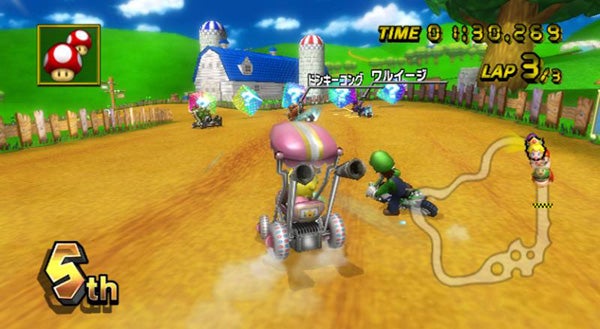
Verdict
Key Specifications
- Review Price: £34.95
With each new iteration of Mario Kart, Nintendo faces an uphill struggle. The original was one of the best-loved games of the 16-bit era. Easy to pick up, satisfyingly deep and sporting a fiercely competitive two-player mode, it defined the kart racing style that a hundred other games would rip off. The problem is that Mario Kart was so definitive that Nintendo itself has never quite managed to make a follow-up that could satisfy the game’s most ardent fans. Mario Kart 64 gave us 3D courses and four-player action, but the fans grumbled about the handling and the track design. Despite being a perfectly fine Kart racer, Mario Kart: Double Dash! on the GameCube fared even worse, mainly because the fans objected to the game’s two riders per kart dynamic, the wider tracks and the merciless behaviour of the AI competition. 
Oddly, only the handheld versions have escaped derision. Of all the Mario Kart sequels – Mario Kart Super Circuit on the GBA played closest to the SNES original. Meanwhile, Mario Kart DS offered a superb combination of all the previous Mario Kart styles and threw in an excellent online game as well.
With Mario Kart Wii, you can see Nintendo trying to keep two camps of people happy. On the one hand, the new Wii Wheel, the integration of the Wii’s user-created Mii characters and an initially generous difficulty level are clearly designed to bring the more casual audience that has adopted the Wii on board. Judging by the game’s huge sales and the fact that, at the time of writing, it’s practically impossible to buy it shows that this has been a success. On the other hand, this is a game that desperately wants to please the old Mario Kart fanbase. It’s packed with tracks from previous Mario Karts, has all the familiar faces (arranged as always into three different weight classes) and allows you to use the Nunchuk controller or a GameCube joypad if you would rather have a more traditional Mario Kart feel. On these terms, however, it’s only a partial success. A lot of people are disappointed or annoyed by Mario Kart Wii, and their reasons aren’t totally ridiculous.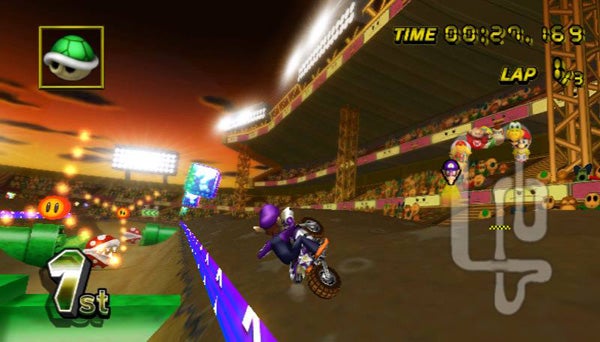
The divisions appear straight out of the box. Considering the fact that it’s really only a circular lump of moulded plastic that encloses a Wii remote, the Wii Wheel is a lovely bit of kit, instantly making the Mario Kart experience that little bit more accessible and that little bit more fun. Yet at the same time there’s no doubt that the motion sensitive controls aren’t as tight or as immediately responsive as the analogue sticks used to be. Nintendo has got around this in two ways. First, the tracks – even those adapted from previous Mario Karts – are wider and the corners slightly more forgiving than they used to be. Secondly, you can just switch to one of the controllers mentioned before, in which case it feels much like it did in the good old days. However, you’re still sitting on the same, wider tracks.
Nintendo has further alienated the ultra-hardcore by messing with the drift and boost mechanics. You can set drift to automatic, making corners easier but losing you the boost you get when coming out of a drift, or you can set it to manual, in which case you jump and then drift like you used to, but the boost is now relative to the length and direction of your drift, not built then used by ‘snaking’ left and right before releasing the trigger. People who hated all the snaking business are quite happy about this, but those who’ve spent years working on their drifts and boosts are not so delighted. For them, a substantial part of the skill has gone.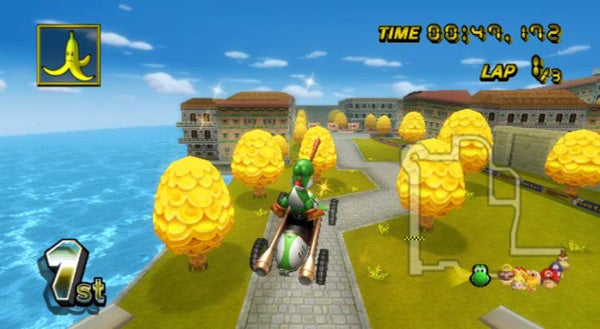
For me and for the greater part of the audience, I suspect it’s a non issue. Playing with the wheel is more fun than playing with the stick, the new boost mechanics suit the wheel, and Nintendo has now thrown in a two new ways to get extra speed. First, stunts. Hit a ramp, jerk the wheel or remote, and your character goes into a cool stunt move, picking up a speed boost when he or she lands. Secondly, the game now features motorbikes, and these motorbikes can wheelie. Jerk up on the remote on a decent straight, and your front wheel soars aloft. You move faster, but be wary: get hit by a missile or another player and you’re even more toast than normal.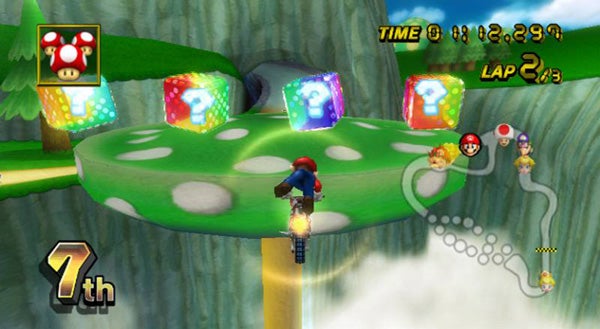
Even if you’ve played Mario Kart before, it will take you a while to get used to all this. On the plus side, at least many of the courses will be familiar. Mario Kart Wii has the cream of the crop of past Mario Kart courses along with a reasonable selection of new ones, with the tracks arranged into eight different cups. Four of these are initially locked and must be unlocked – along with additional playable characters – by getting a podium position in the available cups. Apart from the widening, tracks are surprisingly faithful to their original incarnations. The ghost swamp and beach courses from the SNES and GBA Mario Karts remain flat, and the textures and architecture have been updated rather than replaced. Tracks like the Mario circuit, Moo Mo Farm and DK Jungle tracks will be instantly familiar from their N64 versions, while a scattering of the Mario Sunshine themed courses from Double Dash! have made it through to Mario Kart Wii.
The downside of this approach is that few of the remade courses have an awful lot of wow factor, but to make up for it the new ones – mostly collected in the latter cups – are superb. Koopa Cape has some terrifying drops and some brilliant river and underwater sections, while the lava-filled Grumble Volcano is the sort of course that punishes rash racing lines or dozy play. Maple Treeway, with its narrow, twisting branch tracks, is one of the most fiendish Mario Kart courses I’ve ever played. Coconut Mall, meanwhile, makes the best use of your systems’s selection of Miis. While other tracks feature them as spectators, the Mall has them as obstacles, reversing cars in the car park that are guaranteed to get into your kart’s way. It’s the sort of nice touch that distinguishes the best Nintendo games.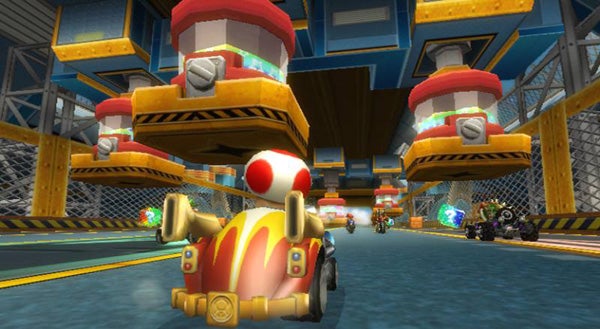
Now, unless you’re really hot under the collar about the changes to the handling and the boost model, I think you’ll find Mario Kart Wii a hugely entertaining single-player game. As always, the action is divided into three classes, 50CC, 100CC and 150CC, with the 100CC now restricted to motorbikes only. Old hands will find the 50CC class pretty easy going, which is fine as its designated a beginner’s class. The 100CC class also lacks challenge early on, but picks up in the later cups as the courses grow more challenging and it gets harder to push ahead of the chasing pack.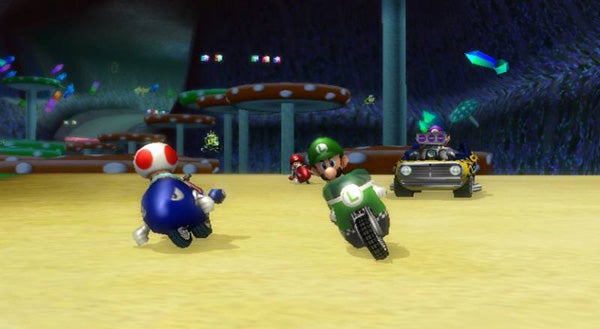
With 12 karts or bikes on track at any time, there’s a lot of carnage in the new Mario Kart, and new weapons like the Bullet Bill, where you become the eponymous bullet and smash your way along the track for a short period, up the ante quite considerably. By the time you get to the 150CC class this can make the going very hard indeed, and while you can get the occasional win by hitting first pace early on and hoping that the racers in the pack fight among themselves, the usual Mario Kart habits – rubber banding the racers so that slower karts can catch up and dishing out less powerful weapons while you’re in front – make the majority of races a real struggle. This is exactly as it should be, and it’s this – plus the constant attraction of finding the perfect racing line and the best place to pull off stunts and boosts – that gives the game some of its long-term appeal.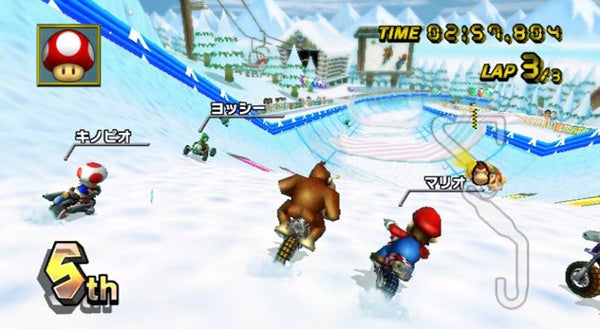
Some, but not all, because the real pull of Mario Kart has always been playing with friends. Time trials and two to four player races will keep your household busy for some time, even if there will be grumbles about the fact that the eight to ten racers who complete the line-up can give unlucky human players such a pounding that not all of the Wii remote throwing will be accidental. And if it’s one thing to know that your partner or flatmate has just beaten your course record, it’s another thing to see it represented by their grinning Mii standing ahead of yours on a visual display; an insult only racing and beating their saved ghost will allay.
However, Mario Kart Wii follows Mario Kart DS by taking the competition online too. As always, hooking up via the Nintendo Wi-Fi Connection service is a breeze, and the game soon finds up to eleven other racers – on your continent or worldwide as you choose – to race against. Oddly, there’s something more personal and infinitely more charming about a race against strangers when its preceded by the sight of their waving Miis, and you won’t miss the grumping and trash-talk of Forza 2 or PGR4 on Xbox Live one bit. The racing itself is hilarious, and while I’ve had the odd dropped game or sudden disconnection, it has mostly been impressively lag-free.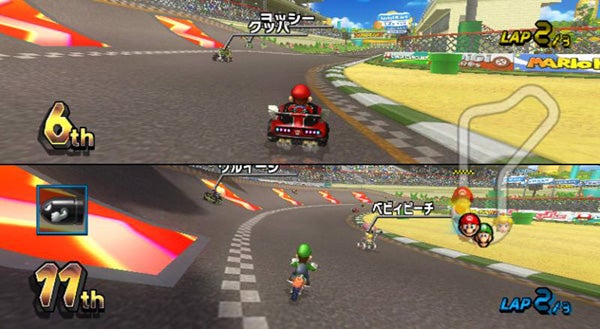
Yet Nintendo hasn’t stopped with just a multiplayer option. You can access a new Mario Kart channel, either within the game or installed to your Wii’s main Channels page, then instantly look to see whether your track times are being beaten, what your friends are up to and whether anyone is looking for a game. You can see where your achievements rank against other players, join competitions, or even download random Time Trial ghosts to tackle. It’s all beautifully done, and just leaves you hoping that Nintendo can offer similar options in future games. What’s more, completing a specific championship in the single-player mode allows you to play online and offline with your own Mii. Cleverly, the game assigns a weight class based on your Mii’s own physique. 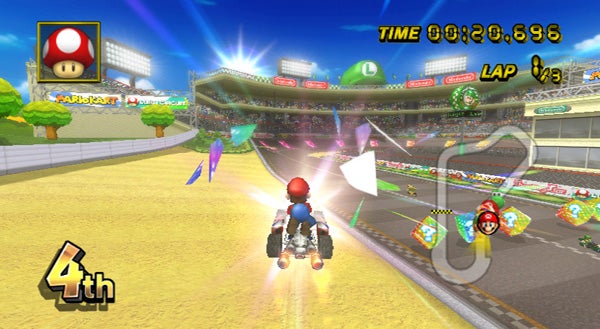
For me, it’s the online mode that pushes a very, very good game up to greatness. I know some hardcore fans will have other grumbles – like the fact that the classic Battle mode is now a team-based shadow of its former glory – but for me this hardly impacts. Nor does it really matter that the graphics aren’t what you might call amazing; Double Dash! was arguably a bigger leap forward visually, and there are only a few courses where the scenery or the enhanced lighting engine really shines. What matters to me is whether the wheel works, the online option works, and whether the game is hugely addictive and massively entertaining. On all these counts my answer is an unqualified ‘yes’. Hardcore Mario Kart players are free to disagree and moan, and can dock one to three points off my score as they wish. The rest of us can just get on and enjoy what is still the finest kart racing game known to man.
”’Verdict”’
The new Mario Kart will please the Wii’s casual audience better than Nintendo’s hardcore fanbase, but relax, enjoy the new features and the nostalgia factor, and it’s still an exemplary racing game.
Trusted Score
Features
| Player(s) | 12 |
| Online Multiplayer | With Online Multiplayer |

